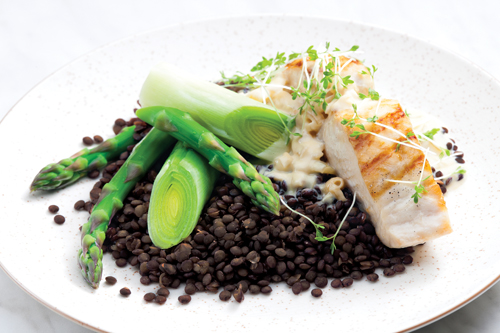The prenatal diet du jour

There’s no question that what a woman eats during pregnancy […]
There’s no question that what a woman eats during pregnancy can play a huge role in fostering the health of both mom and her tiny tadpole. And if you’re already making smart dietary choices by eating foods like salmon and yogurt, you are well on your way to the healthiest nine months possible.
But a regular rotation of the same edibles can quickly lead to a serious case of dietary burnout. Suddenly, that plate of chicken and broccoli seems a lot less appetizing, and the urge to order greasy pizza heightens. Rather than languishing in the dietary doldrums, tickle your taste buds again by infusing your pregnancy diet with some exciting new foods that deliver not only unique flavors but also the nutrients needed to help you and baby stay healthy. Start with these five standouts …
Sablefish
Ladies with baby bumps should aim to consume about 12 ounces of seafood each week, according to the USDA. But if you’re sick of salmon, try nailing this quota with the help of sablefish. Haven’t heard of it? Full of omega-3s, sablefish (also called black cod) harbors a boatload of healthy fats that have been shown to benefit a growing baby’s eye and brain development. Research also suggests that elevated intakes of marine-sourced omega-3 fats during pregnancy can slash the risk for prenatal depression. A mere 3 ounces of this swimmer has a whopping 1,400 milligrams of omega-3s, about 30 percent more than many salmon options.
In the kitchen: The buttery flesh of sablefish will have you hooked at first bite. Similar to halibut and tilapia, it can be steamed, broiled, poached, baked, seared in a skillet or tossed on the grill. It works well when paired with fresh salsas and glazes.
Black lentils
Also known as beluga lentils (their shiny jet black appearance resembles beluga caviar), black lentils are notably less earthy tasting than green lentils. But like their legume counterpart, they are a leading source of dietary folate. When consumed in adequate quantities early on during pregnancy, folate helps prevent birth defects of the spine and brain. What’s more, Dutch researchers found that children whose mothers took in more folate while pregnant were less likely to have emotional problems than tykes whose mothers were folate deficient. Black lentils also provide a windfall of dietary fiber and the protein needed to help build up developing tissues and organs.
In the kitchen: Beyond their great taste, black lentils boast the advantage of a short cooking time; it takes only 20 minutes in a pot of simmering water to make them slightly tender. These lentils also hold their shape when cooked and make a stellar addition to soups or salads.
Kefir
If you’re already comfortable with yogurt, it’s time to give kefir a try. As with yogurt, tangy kefir is made by fermenting milk to produce a dairy product laced with pro-biotics. But kefir reigns supreme when it comes to bacterial firepower, as it has three times the amount of probiotics found in typical yogurt.
Beyond improving immune and digestive health and fending off yeast infections during pregnancy, probiotics are friendly microcritters that can even cut the risk for preeclampsia (a potentially dangerous spike in blood pressure during pregnancy) by about 20 percent, according to a study published in the American Journal of Epidemiology. Kefir also provides a payload of calcium to bolster the strength of your baby’s bones and teeth. And keep spooning this great white after delivery, as probiotics have been shown to help trim postnatal belly fat.
In the kitchen: Liquid kefir makes a powerful addition to smoothies or a batch of pancakes. For a healthy snack, top a bowl of thicker kefir with berries and chopped nuts.
Chia
Once famously hawked as a novelty product to the tune of ch-ch-ch-chia, chia seeds are experiencing a renaissance as a bona fide superfood. What tiny chia seeds lack in size, they make up for with impressive amounts of dietary fiber—11 grams in each ounce. Remember, a high fiber diet is important during your pre-natal days to help prevent constipation and regulate blood sugar levels, lowering the risk for gestational diabetes. Chia seeds’ nutritional highlights also include the bone-building trio of calcium, phosphorus and magnesium.
In the kitchen: Granola, smoothies and salads are better with a sprinkling of chia seeds. Also take advantage of chia seeds’ ability to absorb several times their weight in water, and use them to make a tapioca-like gel that’s ideal for thickening puddings and fruit spreads.
Teff
If you’ve had your fill of quinoa, branch out into other exotic whole grains like teff. Reddish-brown in color, teff is one of the world’s smallest grains and has a long history in Ethiopia where it’s made into injera, a traditional fermented spongy flatbread. Because of its itsy-bitsy size, machinery is not able to separate teff into its germ, bran and endosperm layers to create a refined grain similar in fashion to white flour. This makes teff a nutritional giant that’s rich in a range of nutrients including fiber, magnesium, calcium and phosphorus. Teff is also higher in iron than most other grains. The requirement for iron is elevated during pregnancy to support increased production of hemoglobin, a protein that carries oxygen to your cells and those of your growing baby for proper development. Further, iron-deficiency anemia during pregnancy is associated with preterm delivery and low birth weight.
In the kitchen: Teff has a malty, nutty flavor and expunges its starch during cooking, so it can easily be made into a nutritious pudding or breakfast porridge similar in consistency to Cream of Wheat. Or, use it in place of cornmeal for a riff on polenta. You can even use nutritious teff flour in your pancakes, waffles and baked goods as a substitute for regular flour.







